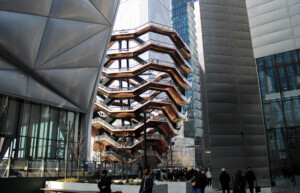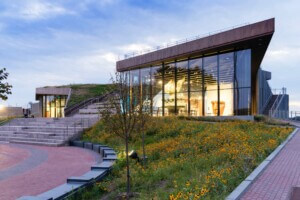In the wake of a slew of criticisms on numerous glass skyscrapers’ over-reflective properties, some architects and critics are asking if it’s time to reassess our view on using glass facades in the future.
Contemporary architecture today is at a crossroads: Do we continue to enamor the structures that reach up into the sky in a display of corporate might with reflective sheaths of glass? Take advantage of the new technology that is allowing the sun to power these buildings? Or do we take a step back and re-evaluate our position on the all-glass facade altogether? Fred A. Bernstein of the Architectural Record laments that today the “relentless repetition of glass facades leads to a numbing sameness.”
“Is that a building?” said a designer to Bernstein , “I thought it was a pavilion for a plexiglass convention.” It’s no surprise that the person, who was passing by Fumihiko Maki‘s creation at 51 Astor Place, feels disillusioned. At one end of the spectrum, you have cities like Bath in England where such glass behemoths are nowhere to be found. You are surrounded by the Georgian works of John Palmer, who’s Lansdown Crescent, despite its scale, is not overwhelming. At the other end, you have cities like Hong Kong and Shanghai, which are filled with an unprecedented amount of glass high-rise structures, their facades lost in the sky with light bouncing off one another.
Where then, do we draw the line?
With modern skyscrapers being the architectural product of an ever changing, neo-liberalist, globalization obsessed corporate society, such a line may even be impossible to draw.
The case for glass—to pardon the pun—is clear. For companies, having floor to ceiling windows helps break down the stratified hierarchy that was once commonplace in such office buildings by giving all employees, not just the boss, a panoramic view. When used effectively, an elegant glass facade can convey honesty and open-mindedness and even perhaps financial transparency. This may be why the style is so popular amongst financial firms, despite the fact this isn’t always the case.
Developers are also under pressure to maximize space. Having a thin skin such as glass is an easy solution that enables the architect to sell the building’s space as good value for money. Plus, the advancement of photovoltaic cells now means that they can be installed as windows, further advocating the facade style as an economically viable asset. PV company SolarWindow, which specializes in PV-based window solutions claims that when installed on four sides of a 50-story building, 1.3 gigawatt-hours of energy can be generated.
Architect Ken Shuttleworth however, has different ideas. Despite being part of the team behind the glass clad Swiss Rae building in London, he has since done a U-turn by stating that he is “rethinking” everything he as done in the last 40 years. Shuttleworth’s voice is echoed by many in what is an emerging discourse on the glass structures that run the risk of becoming the scourge of the skyline. “We need to be much more responsible in terms of the way we shade our buildings and the way we thermally think about our buildings,” he told the BBC last year.
The only thing that appears to be halting the perpetual rise of the glass facade in the United States is a shortage in the material. Failure of the market to produce however, has not stopped developers, who according to WSJ’s Robbie Whelan, have now delved into the glass manufacturing industry. Developer, Related Cos has even gone so far as to take production methods into its own hands—building its own glass factory to create the largest private development in American history. Bruce Beal Jr., Related’s president chose to embark on the endeavor for a handful of skyscrapers and apartments on Manhattan’s West Side as part of the Hudson Yards scheme.
Across the Atlantic, the trade association “Glass for Europe” is understandably keen to dismiss the growing concern about the once ubiquitous glass facade and advocate the fact that glass is fully recyclable.
Pressure from trade unions isn’t enough it seems to sway architecture critic Tom Dyckhoff who, like Shuttleworth, isn’t a fan of the glass skyscraper. Speaking to the BBC he said, “as someone who spends their entire life staring at buildings, I am a bit bored by the glass box. They were radical in the 1920s and now they are just cliches, expensive ones at that,” he said.
“Now we are having to be more thoughtful about how and where we use glass. Maybe architects will become more inventive in how they use windows, instead of plastering them across whole facades.”
Technological advancements may be the only way this question will truly be answered, but for now, money talks and that appears to be what governs the modern architectural style today.










